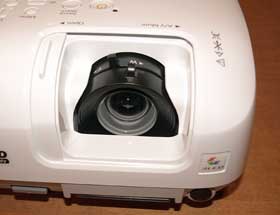From the top:
The Power button is a small orange affair on the top left side of the remote control. YOu press once to power up, or twice to power down. Across from it (to the right) is a button labeled Search. Pressing it will have the Epson projector search the inputs and select the first active source it finds. Directly below those two buttons are six direct "source" buttons, including Computer, S-Video, (composite) Video, USB, HDMI, and one labeled Slideshow (slideshow lets you view images from the projector's SD card slot. That means you can take the memory card out of most digital cameras and plug it right in. Or, if your camera uses other memory cards such as XD, you can get an adapter. All considered, the Slideshow feature is a nice touch for viewing those family vacation, etc. photos.
The next row has three buttons, from the left, an A/V mute (mutes picture, and also sound (if you are feeding sound into the projector, which does have a speaker). The middle button freezes the image on the screen. The right one has no function (more on this below). The next row has (from the left) Auto (the projector sets up the image for you, Aspect ratio, and Color Mode (which lets you toggle between the many picture modes. To the right of those three is a Number button. You can see on the remote that many buttons have dual uses, and this turns on the Numeric mode, so that the buttons become a keypad instead of selecting features. The Numeric keypad can be used to input security codes, to lock the use of the projector. This is a fairly common feature on business projectors as a theft deterent, but rarely found on a home projector.
The next two rows are more business oriented than home. On the left there is a Page Up, and below it, Page Down, for advancing presentations, and right next to those two are a pair that allows zooming in or out of an image. There's also a green button with a ? on it. This brings up Epson's interactive help system. It's a nice touch, as instead of just answering questions it lets you make the changes without having to locate the right controls in the menu system. I've always liked it, but at the same time, it's rather thin, in terms of the areas of help. It would be much better if expanded to cover more topics. Below the Help button are the Volume up and down buttons.
All that leaves are the menu controls at the bottom. There's a small round Menu button to launch the menu system, and across from it, on the right, is the ESC button to take you back one level in the menus. Right below these two, you'll find the classic navigation system in an oval pattern with up/down/left/right arrows and an Enter button located in the center.
Epson claims a range for the remote of 19.7 feet. From using it, that's very believable. I had no trouble bouncing the remote's signal off of my screen, to the Epson projector for a round trip of about 23 feet.
That covers it for the remote. Not bad, definitely functional, but as they say - "nothing to write home about".
It should be noted, that the Home Cinema 700's LCD panels project a 1280x800 image, not the standard 1280x720 which is 720p. It is the only stand alone 3LCD projector I am aware of, that uses the 16:10 1280x800.
So that you understand, 1280x800 is referred to as WXGA (not 720p), and is the standard for most widescreen laptop computers. This goes back to the Home Cinema 700's roots as a crossover projector, sharing the same LCD panels as the virtually identical Epson Powerlite W6 projector, which is marketed as a business and education projector.
All considered, the Home Cinema 700 is a "crossover" projector, one suitable for typical business presentations but one with sufficient image quality to double as an entry level home projector as well.
Those of you buying a home screen for the Epson should understand that there will be a bit of overshoot above and below the screen, due to the extra 80 pixels of vertical height. That means you will have (for a 100" screen) a little less than 2.5 inches of letterboxing that is "off the screen". Most or all of that would hit the black border of the screen frame, depending on the screen. The overshoot will be the "blackest black" - in reality dark gray light. It is the same dark gray as the letterboxing you would have above and below a typical movie (2.35:1) when shown on a standard 16:9 screen.
Home Cinema 700 Lens Shift
The Home Cinema 700 does not have lens shift. Adding lens shift would increase the price. If you are interested in an Epson projector with greater placement flexibility, there's the Home Cinema 720, a projector for the more serious enthusiast, which is only a few hundred dollars more. Other 720p projectors with lens shift include the Panasonic PT-AX200U and the Sanyo PLV-Z60.
The projector has a small amount of offset. For that same 100" diagonal 16:9 screen, the center of the projector's lens would sit 2.7 inches below the bottom of the screen surface. Or, if you are ceiling mounting, the projector mounts inverted, and would have its lens 2.7 inches above the top of the screen surface. All these numbers are from the Epson manual.


